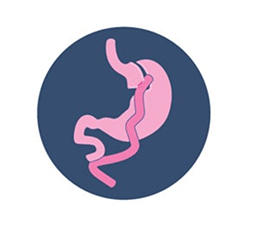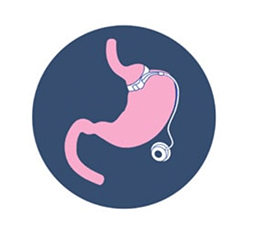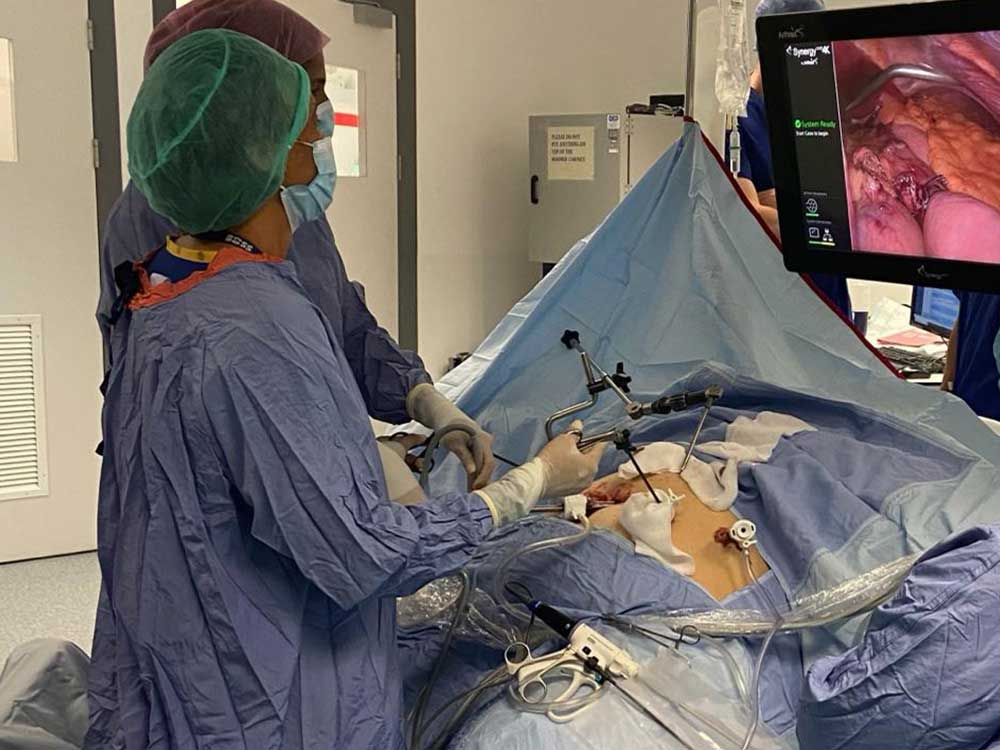Gastric balloon
Weight Loss (Bariatric) Surgery
Weight-loss surgery, also known as bariatric surgery, is an operation that makes changes to the digestive system. It is intended for people who have obesity and need to lose weight but have not been able to do so through other means. These operations are carried out under a general anaesthetic using very small cuts and is called laparoscopic or key hole surgery.

Gastric Sleeve
What is Gastric Sleeve Surgery?
The gastric sleeve or sleeve gastrectomy, is a restrictive procedure, which reduces the volume of the stomach. Keyhole surgery is used to remove 80-90% of the stomach, changing it from an expandable reservoir for eaten food, to a narrow tube.
By removing, the part of the stomach that contains cells that release the appetite controlling hormone ghrelin, the surgery makes patients less hungry. The capacity of the sleeve is much less than a normal stomach, so portion sizes are much smaller.

Roux-en-Y Gastric Bypass
Roux-en-Y Bypass Surgery is the gold standard against which all other obesity operations are judged. First performed as an open operation in 1967, it has stood the test of time. Now performed with laparoscopic surgery, patients stay in hospital for one or two nights and will usually return to work within two weeks.It may be a preferred option for patients with reflux symptoms and also those with type 2 diabetes.
Using key-hole surgery, under general anaesthetic, a small rectangular, pouch is formed from the upper stomach. The remainder of the stomach is not removed; it remains healthy, with a good blood-supply, producing hydrochloric acid needed to sterilise food, enzymes needed to start digesting carbohydrates and a special protein needed to absorb vitamin B12.
The small intestine is re-configured into a Y shape, using staplers to divide and join the intestine. The free end of the Y, is joined to the small pouch.
One Anastomosis Gastric Bypass (OAGB)
Also called ‘mini gastric bypass’ or ‘Omega loop gastric bypass’ was conceived by Dr R. Rutledge in 1997. Several studies have demonstrated that it is a rapid, safe and effective bariatric operation.
The operation involves creating a long and narrow lesser curve gastric pouch which helps with restriction and a 150cm-200cm jejunal bypass with an antecolic gastro-jejunostomy (GJ) anastomosis, which leads to significant (fat) malabsorption.
The expected weight loss is at least comparable to the Roux-en-Y gastric bypass and the Sleeve Gastrectomy (range- 30-40% body weight loss) and also resolution of comorbidities such as diabetes and sleep apnoea.

Gastric Band
It is the least preferred option due to less weight loss compared to gastric sleeve or gastric bypass. Also, the risk of complications, failure and intolerance of band are higher. Any revisional surgery following a band also carries a higher risk.
The gastric band is placed just below the oesophagus, at the top of the stomach, with a very small pouch of stomach above the band. The Lap-Band can be adjusted, by injecting saline, through an access port, buried beneath the skin of the abdominal wall. As saline is added to the gastric band, the pressure on the upper stomach increases; this increased pressure reduces appetite. When the gastric band is correctly adjusted patients become much less interested in food, with control of their appetite. This is the key to success; diets usually fail, because patients cannot sustain the intense will power needed to fight their appetite day after day, month after month when dieting. By inhibiting appetite, the gastric band allows patients to work with a diet. In addition to controlling appetite, the gastric band makes patients slow down when they eat, reducing portion size. Daily calorie intake is reduced by controlling portion size and reducing appetite, with steady weight loss following. Patients need to be prepared to work hard with the gastric band, to get the weight loss they want.
Weight Loss (Bariatric) Surgery
Weight-loss surgery, also known as bariatric surgery, is an operation that makes changes to the digestive system. It is intended for people who have obesity and need to lose weight but have not been able to do so through other means. These operations are carried out under a general anaesthetic using very small cuts and is called laparoscopic or key hole surgery.

Gastric Sleeve
What is Gastric Sleeve Surgery?
The gastric sleeve or sleeve gastrectomy, is a restrictive procedure, which reduces the volume of the stomach. Keyhole surgery is used to remove 80-90% of the stomach, changing it from an expandable reservoir for eaten food, to a narrow tube.
By removing, the part of the stomach that contains cells that release the appetite controlling hormone ghrelin, the surgery makes patients less hungry. The capacity of the sleeve is much less than a normal stomach, so portion sizes are much smaller.

Roux-en-Y Gastric Bypass
Roux-en-Y Bypass Surgery is the gold standard against which all other obesity operations are judged. First performed as an open operation in 1967, it has stood the test of time. Now performed with laparoscopic surgery, patients stay in hospital for one or two nights and will usually return to work within two weeks.It may be a preferred option for patients with reflux symptoms and also those with type 2 diabetes.
Using key-hole surgery, under general anaesthetic, a small rectangular, pouch is formed from the upper stomach. The remainder of the stomach is not removed; it remains healthy, with a good blood-supply, producing hydrochloric acid needed to sterilise food, enzymes needed to start digesting carbohydrates and a special protein needed to absorb vitamin B12.
The small intestine is re-configured into a Y shape, using staplers to divide and join the intestine. The free end of the Y, is joined to the small pouch.
One Anastomosis Gastric Bypass
Also called ‘mini gastric bypass’ or ‘Omega loop gastric bypass’ was conceived by Dr R. Rutledge in 1997. Several studies have demonstrated that it is a rapid, safe and effective bariatric operation.
The operation involves creating a long and narrow lesser curve gastric pouch which helps with restriction and a 150cm-200cm jejunal bypass with an antecolic gastro-jejunostomy (GJ) anastomosis, which leads to significant (fat) malabsorption.
The expected weight loss is atleast comparable to the Roux-en-Y gastric bypass and the Sleeve Gastrectomy (range- 30-40% body weight loss) and also resolution of comorbidities such as diabetes and sleep apnoea.

Gastric Band
It is the least preferred option due to less weight loss compared to gastric sleeve or gastric bypass. Also, the risk of complications, failure and intolerance of band are higher. Any revisional surgery following a band also carries a higher risk.
The gastric band is placed just below the oesophagus, at the top of the stomach, with a very small pouch of stomach above the band. The Lap-Band can be adjusted, by injecting saline, through an access port, buried beneath the skin of the abdominal wall. As saline is added to the gastric band, the pressure on the upper stomach increases; this increased pressure reduces appetite. When the gastric band is correctly adjusted patients become much less interested in food, with control of their appetite. This is the key to success; diets usually fail, because patients cannot sustain the intense will power needed to fight their appetite day after day, month after month when dieting. By inhibiting appetite, the gastric band allows patients to work with a diet. In addition to controlling appetite, the gastric band makes patients slow down when they eat, reducing portion size. Daily calorie intake is reduced by controlling portion size and reducing appetite, with steady weight loss following. Patients need to be prepared to work hard with the gastric band, to get the weight loss they want.
Revisional Bariatric Surgery
Whilst bariatric surgery is a proven weight loss solution that has been successfully employed for decades, there are occasions when patients do not achieve the weight loss that they expect (or begin to regain weight several years after their procedure). Lack of weight loss or weight regain may be caused by one or more of many factors and need to be evaluated by a surgeon with extensive experience in revising primary bariatric procedures together with his multidisciplinary team.
Before considering revision to a primary bariatric procedure, it is important to understand that most patients will regain a little bit of weight in the future. This is perfectly normal and is not considered a complication requiring a revision.
The most common cause of insufficient weight loss is straying from the postoperative diet and exercise regimen. Over the years, it can get harder to maintain a strict diet and exercise program, and small lapses can compound over time. If a lifestyle issue is the primary cause of weight regain, our team of dieticians and psychologists will work with our patients to get back on track. Often, with renewed dedication to their health and new lifestyle, patients can begin to lose weight again. We can also add medications to help promote further weight loss.

